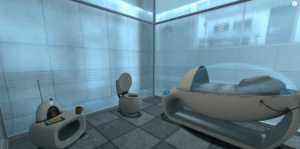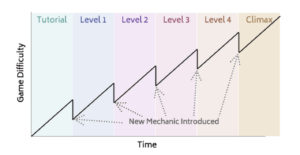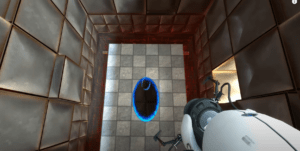This critical play, I indulged in Portal, a puzzle-platforming game developed and published by Valve and is available on Windows, MacOS, many of last-last generation consoles, and the Nintendo Switch and Android for some reason. There is some dry and irreverent humor in the game, making it best for preteens and older. As the name implies, the puzzle mechanics are integral to the game’s experience; their physics-motivated reasoning combined with the Aperture Science’s sterile testing atmosphere made me feel like a human lab rat with GLaDOS’s snide comments as my cheese.
I had never played Portal before, though I’d seen my brother play its sequel, so I had some expectations for the puzzle dynamics going in. The opening scene, however, was a lot more humble than I expected: No portal gun, just me. Walking.

(Introductory room – not a portal to be found)
The first few test chambers, I completed tasks by leveraging nothing more than the control stick. From then on, portals are introduced, then the portal gun (with only one portal, which surprised me), then momentum with the portals, bombs, finally the portal gun gets its two portals, and I stopped before fending off some turrets. This gradual progression is vital to the puzzle flow—. The early levels are also designed to accustom you to the physics of the game: I remember GLaDOS’s comment on momentum before a chamber, and what do you know, breaking the laws of conservation of momentum was the theme of the chamber. Later levels, after a few learning levels have been done, act as benchmarks to combine all of the topics I handled individually, sculpting an incredibly satisfying experience. The difficulty scaling is very reminiscent of what we discussed in class.

To get into the specific physics of the game, they are quite exhilarating. Portals…are abominations to the laws of physics. But the way they’re presented in-game, you wouldn’t even notice because of how naturally they flow. When I accelerate towards the ground, my momentum carries through portals that shoot me horizontally. And I was quite comfortable with this because the mechanic is drenched in my intuition for motion. I’m no physicist, but fast thing comes in, fast thing goes out, pretty simple. The harder puzzles had me angling bouncing bombs, but there were always earlier rooms that let me explore the concepts safely before I was at significant risk of being exploded. Furthermore, the abundance of portal surfaces allows the player to mess around with the mechanics, attempt many things. And no failed attempt is really that frustrating because I learned something new about the physics for me to exploit.

(Me jumping to my demise but there’s a portal there)
The physics mechanics also have great interplay with the aesthetics at play. Every time a portal is shot, there’s a satisfying “pshoo” before a “gwomp,” and the portal is down. Very sciencey, very appropriate for the test setting I’m in. GLaDOS, in all her synthetic glory, fires quips in her beep-boop voice, and they’re pretty amazing. Her robotness is right at home with the rest of the presentation, but she also ironically adds so much humanity to the game. Even though she’s a robot, she’s clearly got personality. Chell, in typical video game fashion, is a silent protagonist, and so the burden falls on GLaDOS to liven up the setting. The way she insults the player is not only charming but also motivating cause screw that robot. I’ll show her. Every chamber I’d enter, she’d say something upsetting and hilarious before I conducted the test and I’d always want to know the end of her thought, which would be my reward at the end of the test, subtly giving me some verbal cheese to satiate my hunger for human connection.




